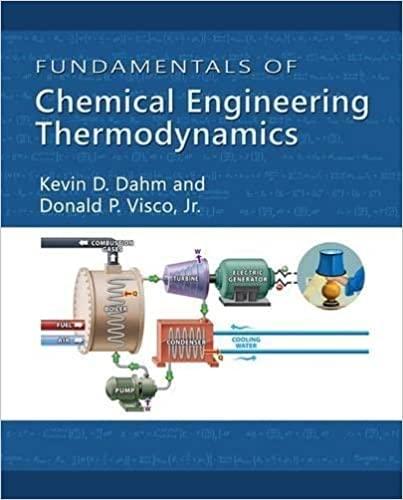Example 14-6 examined the thermal decomposition of butane forming propylene: C 4 H 10 C 3
Question:
Example 14-6 examined the thermal decomposition of butane forming propylene:
C4 H10 ↔ C3 H6 + CH4
But a competing thermal decomposition reaction forming ethylene and ethane is also possible:
C4 H10 ↔ C2 H4 + C2 H6
and ethane can react further as
C2 H6 ↔ C2 H4 + H2
Assume these are the only three reactions that occur. Use the shortcut van ’t Hoff method to calculate rate constants.
A. 10 mol/s of butane enter a reactor at T = 298 K and P = 1 bar. The exiting stream is at T = 1000 K and P = 1 bar and is at equilibrium. At what rate is heat added to the reactor, and what is the composition of the exiting stream?
B. 10 moles/s of butane and 10 mol/s of nitrogen enter a reactor at T = 298 K and P = 1 bar. The exiting stream is at T = 1000 K and P = 1 bar and is at equilibrium. At what rate is heat added to the reactor, and what is the composition of the exiting stream?
C. 10 mol/s of butane enter a reactor at T = 1000 K and P = 1 bar. The reactor is isobaric, adiabatic, and large enough for the contents to reach equilibrium. Find the temperature and composition of the outlet stream.
D. 10 moles/s of butane and 10 mol/s of nitrogen enter a reactor at T = 1000 K and P = 1 bar. The reactor is isobaric, adiabatic, and large enough for the contents to reach equilibrium. Find the temperature and composition of the outlet stream.
Example 14-6.
Propylene (CH3-CH5CH2) can be formed by the gas phase thermal cracking of n-butane:
C4H10↔C3H6 + CH4
A steady-state reactor (Figure 14-5) is maintained at a constant T = 500 K and a constant P. The feed to the reactor is 10 mol/s of n-butane. Assuming the stream leaving the reactor is at equilibrium, find the flow rate of propylene in the stream for each of the following cases.
A. The vessel has P = 1 bar.
B. The vessel has P = 25 bar, and the contents are modeled as an ideal gas mixture.
C. The vessel has P = 25 bar, and the mixture fugacity of each compound is determined from the Peng-Robinson equation.
The reaction at 500 K has an equilibrium constant K500 = 0.931.

Step by Step Answer:

Fundamentals Of Chemical Engineering Thermodynamics
ISBN: 9781111580704
1st Edition
Authors: Kevin D. Dahm, Donald P. Visco





